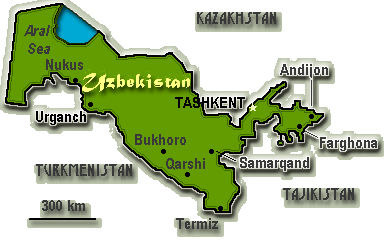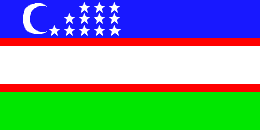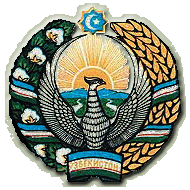Uzbekistan

Geography
Location: Central Asia, bordering the Aral Sea, between Kazakhstan and TurkmenistanArea:
total area: 447,400 sq km
land area: 425,400 sq km
comparative area: slightly larger than CaliforniaLand boundaries: total 6,221 km, Afghanistan 137 km, Kazakhstan 2,203 km, Kyrgyzstan 1,099 km, Rajikistan 1,161 km, Turkmenistan 1,621 km
Coastline: 0 km
note: Uzbekistan borders the Aral Sea (420 km)Maritime claims: none; landlocked
International disputes: Russia may dispute current de facto maritime border to midpoint of Caspian Sea from shore
Climate: mostly midlatitude desert, long, hot summers, mild winters; semiarid grassland in east
Terrain: mostly flat-to-rolling sandy desert with dunes; broad, flat intensely irrigated river valleys along course of Amu Darya and Sirdaryo Rivers; Fergana Valley in east surrounded by mountainous Tajikistan and Kyrgyzstan; shrinking Aral Sea in west
Natural resources: natural gas, petroleum, coal, gold, uranium, silver, copper, lead and zinc, tungsten, molybdenum
Land use:
arable land: 10%
permanent crops : 1%
meadows and pastures: 47%
forest and woodland : 0%
other: 42%Irrigated land: 41,550 sq km (1990)
Environment:
current issues: drying up of the Aral Sea is resulting in growing concentrations of chemical pesticides and natural salts; these substances are then blown from the increasingly exposed lake bed and contribute to desertification; water pollution from industrial wastes is the cause of many human health disorders; increasing soil salinization; soil contamination from agricultural chemicals, including DDT
natural hazards : NA
international agreements: party to - Climate Change, Environmental Modification, Ozone Layer ProtectionNote: landlocked
People
Population: 22,608,866 (July 1994 est.)
Population growth rate: 2.13% (1994 est.)
Birth rate: 30.01 births/1,000 population (1994 est.)
Death rate: 6.51 deaths/1,000 population (1994 est.)
Net migration rate: -2.22 migrant(s)/1,000 population (1994 est.)
Infant mortality rate: 53.2 deaths/1,000 live births (1994 est.)
Life expectancy at birth:
total population: 68.58 years
male: 65.28 years
female: 72.04 years (1994 est.)Total fertility rate: 3.73 children born/woman (1994 est.)
Nationality:
noun: Uzbek(s)
adjective: UzbekEthnic divisions: Uzbek 71.4%, Russian 8.3%, Tajik 4.7%, Kazakh 4.1%, Tatar 2.4%, Karakalpak 2.1%, other 7%
Religions: Muslim 88% (mostly Sunnis), Eastern Orthodox 9%, other 3%
Languages: Uzbek 74.3%, Russian 14.2%, Tajik 4.4%, other 7.1%
Literacy: age 9-49 can read and write (1970)
total population : 100%
male: 100%
female: 100%Labor force: 8.234 million
by occupation: agriculture and forestry 43%, industry and construction 22%, other 35% (1992)
Government
Names:
conventional long form: Republic of Uzbekistan
conventional short form: Uzbekistan
local long form : Uzbekiston Respublikasi
local short form: none
former: Uzbek Soviet Socialist RepublicDigraph: UZ
Type: republic
Capital: Tashkent (Toshkent)
Administrative divisions: 12 wiloyatlar (singular - wiloyat), 1 autonomous republic* (respublikasi, singular - respublika), and 1 city** (shahri); Andijon Wiloyati, Bukhoro Wiloyati, Jizzakh Wiloyati, Farghona Wiloyati, Karakalpakstan* (Nukus), Qashqadaryo Wiloyati (Qarshi), Khorazm Wiloyati (Urganch), Namangan Wiloyati, Nawoiy Wiloyati, Samarqand Wiloyati, Sirdaryo Wiloyati (Guliston), Surkhondaryo Wiloyati (Termiz), Toshkent Shahri**, Toshkent Wiloyati
note: an administrative division has the same name as its administrative center (exceptions have the administrative center name following in parentheses)Independence: 31 August 1991 (from Soviet Union)
National holiday: Independence Day, 1 September (1991)
Constitution: new constitution adopted 8 December 1992
Legal system: evolution of Soviet civil law; still lacks independent judicial system
Suffrage: 18 years of age; universal
Executive branch:
chief of state: President Islam KARIMOV (since NA March 1990); election last held 29 December 1991 (next to be held NA December 1996); results - Islam KARIMOV 86%, Mukhammad SOLIKH 12%, other 2%
head of government: Prime Minister Abdulkhashim MUTALOV (since 13 January 1992), First Deputy Prime Minister Ismail Hakimovitch DJURABEKOV (since NA)
cabinet: Cabinet of Ministers; appointed by the president with approval of the Supreme AssemblyLegislative branch: unicameral
Supreme Soviet: elections last held 18 February 1990 (next to be held winter 1994); results - percent of vote by party NA; seats - (500 total) Communist 450, ERK 10, other 40; note - total number of seats will be reduced to 250 in next electionJudicial branch: Supreme Court
Political parties and leaders: People's Democratic Party (PDP; formerly Communist Party), Islam A. KARIMOV, chairman; Erk (Freedom) Democratic Party (EDP), Muhammad SOLIKH, chairman (in exile); note - ERK was banned 9 December 1992
Other political or pressure groups: Birlik (Unity) People's Movement (BPM), Abdul Rakhim PULATOV, chairman (in exile); Islamic Rebirth Party (IRP), Abdullah UTAYEV, chairman
note: PULATOV (BPM) and SOLIKH (EDP) are both in exile in the West; UTAYEV (IRP) is either in prison or in exileMember of: CCC, CIS, CSCE, EBRD, ECE, ECO, ESCAP, IBRD, ICAO, IDA, IFC, ILO, IMF, IOC, ITU, NACC, NAM, UN, UNCTAD, WHO, WMO
Diplomatic representation in US:
chief of mission: Ambassador Fatikh TESHABAYEV
chancery: Suites 619 and 623, 1511 K Street NW, Washington DC, 20005
telephone: (202) 638-4266/4267
FAX: (202) 638-4268
consulate(s) general: New YorkUS diplomatic representation:
chief of mission: Ambassador Henry L. CLARKE
embassy : 82 Chelanzanskaya, Tashkent
mailing address: use embassy street address
telephone: [7] (3712) 77-14-07, 77-11-32
FAX: [7] (3712) 77-69-53
Economy
CIA Overview: Uzbekistan is a dry, landlocked country of which 20% is intensely cultivated, irrigated river valleys. It is one of the poorest states of the former USSR with 60% of its population living in overpopulated rural communities. Nevertheless, Uzbekistan is the world's third largest cotton exporter, a major producer of gold and natural gas, and a regionally significant producer of chemicals and machinery. Since independence, the government has sought to prop up the Soviet-style command economy with subsidies and tight controls on prices and production. Such policies have buffered the economy from the sharp declines in output and high inflation experienced by many other former Soviet republics. By late 1993, however,they had become increasingly unsustainable as inflation soared and Russia forced the Uzbek Government to introduce its own currency. Faced with mounting economic problems, the government has increased its cooperation with international financial institutions, announced an acceleration of privatization, and stepped up efforts to attract foreign investors. Nevertheless, the regime is likely to resist full-fledged market reforms.
National product: GDP - purchasing power equivalent - $53.7 billion (1993 estimate from the UN International Comparison Program, as extended to 1991 and published in the World Bank's World Development Report 1993; and as extrapolated to 1993 using official Uzbek statistics, which are very uncertain because of major economic changes since 1990)
National product real growth rate: -3.5% (1993 est.)
National product per capita: $2,430 (1993 est.)
Inflation rate (consumer prices): 18% per month (1993)
Unemployment rate: 0.2% includes only officially registered unemployed; large numbers of underemployed workers
Budget:
revenues: $NA
expenditures: $NA, including capital expenditures of $NAExports: $706.5 million to outside the FSU countries (1993)
commodities: cotton, gold, natural gas, mineral fertilizers, ferrous metals, textiles, food products
partners: Russia, Ukraine, Eastern Europe, USImports: $947.3 million from outside the FSU countries (1993)
commodities: grain, machinery and parts, consumer durables, other foods
partners : principally other FSU countries, Czech RepublicExternal debt: $NA
Industrial production: growth rate -7% (1993)
Electricity:
capacity: 11,950,000 kW
production: 50.9 billion kWh
consumption per capita: 2,300 kWh (1992)Industries: textiles, food processing, machine building, metallurgy, natural gas
Agriculture: livestock, cotton, vegetables, fruits, grain
Illicit drugs: illicit cultivator of cannabis and opium poppy; mostly for CIS consumption; limited government eradication programs; used as transshipment points for illicit drugs to Western Europe
Economic aid:
recipient : $125 million by yearend 1993; future commitments for about $500 millionCurrency: introduced provisional som-coupons 10 November 1993 which circulated parallel to the Russian rubles; became the sole legal currency 31 January 1994; will be replaced in July 1994 by the som currency
Exchange rates: NA
Fiscal year: calendar year
Communications
Railroads: 3,460 km; does not include industrial lines (1990)
Highways:
total: 78,400 km
paved and gravel: 67,000 km
unpaved : earth 11,400 km (1990)Pipelines: crude oil 250 km; petroleum products 40 km; natural gas 810 km (1992)
Ports: none; landlocked
Airports:
total: 265
usable: 74
with permanent-surface runways: 30
with runways over 3,659 m : 2
with runways 2,440-3,659 m: 20
with runways 1,060-2,439 m : 19
note: a C-130 can land on a 1,060-m airstripTelecommunications: poorly developed; 1,458,000 telephone circuits with 68.75 circuits per 1,000 persons (1991); linked by landline or microwave with CIS member states and by leased connection via the Moscow international gateway switch to other countries; new INTELSAT links to Tokyo and Ankara give Uzbekistan international access independent of Russian facilities; satellite earth stations - Orbita and INTELSAT; NMT-450 analog cellular network established in Tashkent
Defense Forces
Branches: Army, National Guard, Republic Security Forces (internal and border troops)
Manpower availability: males age 15-49 5,388,456; fit for military service 4,403,497; reach military age (18) annually 222,405 (1994 est.)
Defense expenditures: $NA, NA% of GDP
CIA World Facts (1994)
This page was last up-dated:

